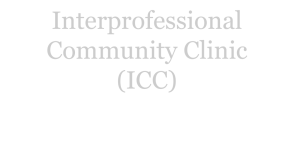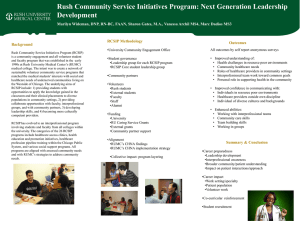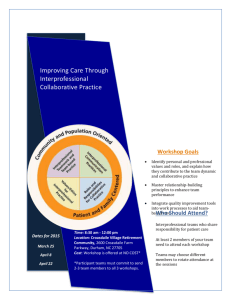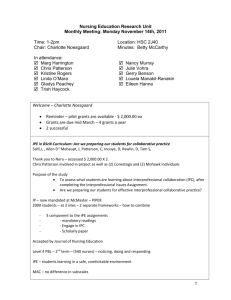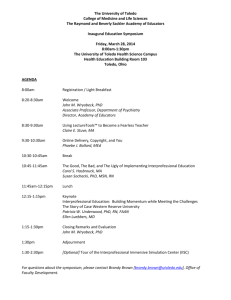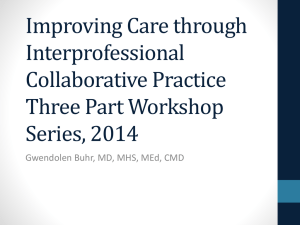File
advertisement
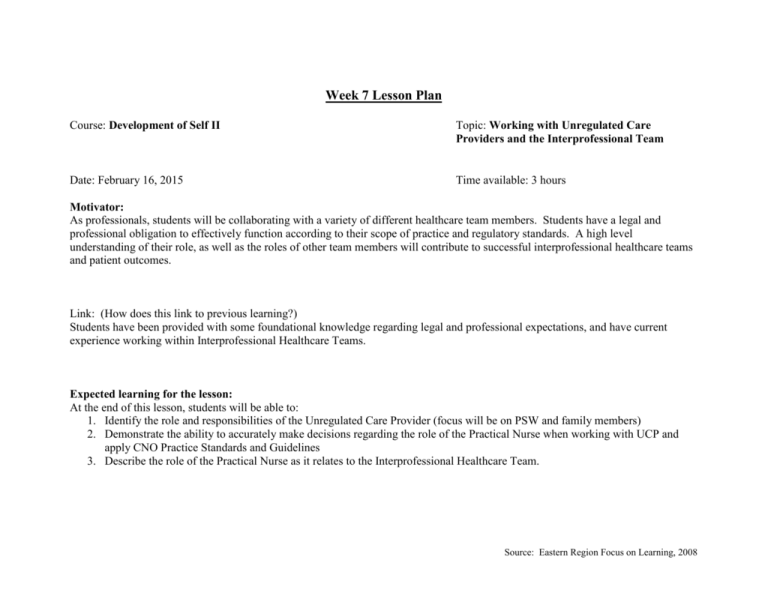
Week 7 Lesson Plan Course: Development of Self II Topic: Working with Unregulated Care Providers and the Interprofessional Team Date: February 16, 2015 Time available: 3 hours Motivator: As professionals, students will be collaborating with a variety of different healthcare team members. Students have a legal and professional obligation to effectively function according to their scope of practice and regulatory standards. A high level understanding of their role, as well as the roles of other team members will contribute to successful interprofessional healthcare teams and patient outcomes. Link: (How does this link to previous learning?) Students have been provided with some foundational knowledge regarding legal and professional expectations, and have current experience working within Interprofessional Healthcare Teams. Expected learning for the lesson: At the end of this lesson, students will be able to: 1. Identify the role and responsibilities of the Unregulated Care Provider (focus will be on PSW and family members) 2. Demonstrate the ability to accurately make decisions regarding the role of the Practical Nurse when working with UCP and apply CNO Practice Standards and Guidelines 3. Describe the role of the Practical Nurse as it relates to the Interprofessional Healthcare Team. Source: Eastern Region Focus on Learning, 2008 Introduction: Students will connect with this topic through discussion; Professor will ask “what experience do you have working with UCP (Unregulated Care Providers) and the IHT (Interprofessional Healthcare Team).” All students have some experiences working as part of the healthcare team, including working with UCP. Many students also have working experience as PSWs (one type of UCP), so hearty discussions often occur. Limit to 10 minutes Key Concepts and Skills 1. Working with UCP Includes review of UCP/PSW role, education, responsibilities and accountabilities 2. The Nurses Role when working with UCP CNO Expectations o Delegation o Supervising o Assigning o Teaching Learning Activities Powerpoint Lecture Role of the UCP Activity Powerpoint Lecture CNO Teleconference Delegating/ Supervising/ Assigning/ Teaching Activity Resources PP, CNO Documents Time 10 mins Activity Materials (chart paper, markers, tape) – case studies will be posted identifying the role of the UCP in various healthcare situations. Students will self-select groups of 4-5, and move to each chart paper. Each chart paper will have a brief scenario description, and each group will add to the suggested UCP role and limitations in each case. 15 mins PP, CNO Documents CNO Teleconference: http://www.cno.org/Global/4LearnAboutStandardsAndGuidelines/prac/learn/tel econferences/UCP/UCP%20teleconference%20for %20July%2025_2012_merged%20content4%20FI NAL.pdf Activity handout – students will be divided into groups based on the colored sticker on the activity handout they receive; they will complete the 10 mins 5 mins 20 mins Source: Eastern Region Focus on Learning, 2008 exercise together and then we will take it up as a class. BREAK 20 mins Key Concepts and Skills 3. The Interprofessional Healthcare Team Team members and roles and Interprofessional Communication Learning Activities Powerpoint Lecture Interprofessional Team – Jigsaw Activity Resources Time PP 10 mins CNO/RNAO Documents Interprofessional Team Activity – students will be placed into home groups (6 per group). Each person in each group will be given a number of 1-6. All #1 will gather together (1-6 same concept). Each group will receive a set of 2 questions to answer based on the content. After 10 mins students will gather in their home groups, and teach fellow students about the questions they answered. 25 mins Source: Eastern Region Focus on Learning, 2008 Summary Activity: Students will be randomly divided into groups of 8. Each group will receive a brief case study description, as well as instructions for this activity. Students will be expected to identify the Interprofessional Team members required, as well as each take on that role. Each student will have a team member role (RPN, PT, OT, RT, PSW, client etc) and identify which member should be the coordinator. The team will identify their unique, as well as their shared roles as they addressed the client goals. They will then debrief the experience, and discuss whether their interprofessional communication supported the client’s needs. 30 min Activity Resources: Case Facilitator Guide - Interprofessional.pdf Freeport Rehab Team Case Scenario-2.pdf Check for understanding: After debriefing within their “teams,” students will regroup as a class, and discuss the content learned and applied in this class. Any questions will be clarified. There will also be three multiple choice questions (similar to test and exam questions) that will be presented using Socrative. Students will use their own personal technology to answer each question (paced by the Professor) and rationale will be reviewed after each question. Links to future learning: Over the next several weeks, students will address the PN role as it relates to Conflict, Leadership and Personal/Professional Change. The Interprofessional Team, and a nurse’s role within that team is the foundation for these concepts. Notes for next time… Source: Eastern Region Focus on Learning, 2008 LESSON PLAN RATIONALE This unit occurs in Week 7 during Semester Four of the PN Program. At this point in the semester, students have a significant amount of clinical experience in a variety of settings, and have reviewed a variety of the legal, professional and ethical responsibilities of nurses. As members of the Interprofessional Healthcare Team, our students are (and will continue to be) working with a variety of other team members. Together, they support client goals and needs, and contribute to the client achieving optimum health and wellness. Often nurses work with Unregulated Care Providers, these most often being PSW (Personal Support Workers) and family members. Nurses must understand their legal and professional obligations when working specifically with these members, and all team members. The role of the Practical Nurse within an Interprofessional Healthcare Team is very specific, but it is also important for team members to understand the roles and responsibilities of their colleagues. Students will be introduced to various other professions and team members, and begin to develop an understanding of the significance of interprofessional communication. The objectives for this unit include: 1. Identify the role and responsibilities of the Unregulated Care Provider (focus will be on PSW and family members) 2. Demonstrate the ability to accurately make decisions regarding the role of the Practical Nurse when working with UCP and apply CNO Practice Standards and Guidelines 3. Describe the role of the Practical Nurse as it relates to the Interprofessional Healthcare Team. My hope is that my Content Delivery meets all three UDL Principles. The first principle, Multiple Means of Representation is evidenced by the presentation of information in a variety of methods. All information will be presented visually (via Powerpoint as well as through the utilization of images/graphics) as well as aurally through Professor presentation as well as class discussion. Additionally, this lesson plan encourages students to consider relevant personal experiences, and guides the students’ ability to apply their knowledge to specific, relevant case studies and scenarios. The second principle, Multiple Means of Action and Expression is demonstrated through the use of a variety of case studies (including a role play-type activity where less comfortable students can choose a less prominent role). Students receive feedback Source: Eastern Region Focus on Learning, 2008 from the professor (as well as each other). Students will also have the opportunity to use technology (Socrative via personal device) to answer sample multiple-choice questions (in preparation for tests and exam). The final principle, Multiple Means of Engagement is, perhaps, the most important principle. My hope is that I have created a class environment that supports (and expects the support of) diversity, and I am considered approachable by my students (office hours, prompt replies to email and phone calls, and overall student comfort with approaching me). I have chosen the specific activities outlined because they incorporate active learning, and encourage discussion and application of knowledge. Although Powerpoints are used to structure my lecture, they will always incorporate visual aids whenever possible (For example, CNO Learning Modules, specific charts from CNO Documents and visual representation of content). Source: Eastern Region Focus on Learning, 2008
